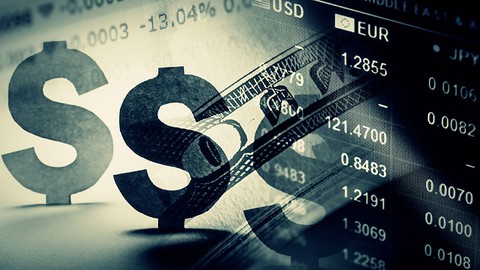
The world of forex trading is a dynamic and ever-changing landscape where countless factors influence currency valuations. One of the most critical concepts that every forex trader must understand is Forex Market Sensitivity to Interest Rate Differentials.
Interest Rate Differentials at the Core
Interest rate differentials are a fundamental and pervasive force within the forex market. These differentials lie at the very heart of currency exchange rates, shaping market dynamics, influencing trading decisions, and playing a pivotal role in global economic interactions. In this comprehensive exploration, we will delve into the significance of interest rate differentials and how they impact the forex market.
1. Understanding Interest Rate Differentials:
- Interest rate differentials refer to the variance in interest rates between two currencies. It is the discrepancy in the yield offered on bonds and other fixed-income securities denominated in different currencies. These differentials form the basis for potential profits and losses in forex trading.
2. Key Factors Contributing to Interest Rate Differentials:
- Central Bank Policies: The primary driver of interest rate differentials is the monetary policy set by central banks. Central banks use interest rates to achieve economic objectives, such as controlling inflation, stimulating growth, or stabilizing financial markets. Decisions on rate changes, monetary easing, or tightening directly impact these differentials.
- Market Expectations: Forex markets are forward-looking, with participants continually assessing the likelihood of future interest rate changes. Expectations of rate hikes or cuts can lead to shifts in interest rate differentials even before central banks take action.
3. Impact on Currency Valuation:
- Interest rate differentials exert a profound influence on currency valuation. Higher interest rates in one country attract foreign capital seeking higher yields, leading to increased demand for that country’s currency. Conversely, lower interest rates can deter foreign investment, weakening the currency.
4. Role in Carry Trade Strategy:
- Interest rate differentials are a core component of the carry trade strategy. Traders seek to profit by borrowing funds in a low-yielding currency and investing them in a high-yielding currency. The interest rate differential, or “carry,” becomes their source of income.
5. Forex Market Reaction to Rate Decisions:
- Central banks’ interest rate decisions trigger significant market reactions. An interest rate hike typically strengthens a currency, as it signals confidence in the economy. Conversely, a rate cut can weaken a currency, reflecting economic concerns or the need for stimulus.
6. Yield Curve Analysis:
- Yield curve analysis involves examining the relationship between short-term and long-term interest rates. Changes in the yield curve can provide insights into a country’s economic outlook, inflation expectations, and potential shifts in interest rate differentials.
7. Inflation Differentials:
- Inflation differentials between countries can also affect interest rate differentials. High inflation erodes the purchasing power of a currency, prompting central banks to raise interest rates to combat it. Inflation-adjusted interest rate differentials can offer a more accurate picture of potential currency movements.
8. Market Sentiment and Risk-on/Risk-off Dynamics:
- Interest rate differentials are closely intertwined with market sentiment. In a risk-on environment, traders may favor currencies with higher interest rates, while in a risk-off environment, they seek safety in currencies like the US Dollar and Japanese Yen.
9. Global Economic Impact:
- Interest rate differentials have far-reaching consequences beyond forex trading. They influence capital flows, trade balances, and investment decisions, impacting economic stability and growth on a global scale.
Higher Interest Rates Attract Capital
Higher interest rates have a substantial influence on the flow of capital within an economy. This phenomenon, driven by the fundamental principles of finance and investment, plays a crucial role in shaping the economic landscape. Let’s delve deeper into how higher interest rates attract capital and the implications of this dynamic:
1. Enhanced Returns on Investment:
- One of the primary reasons higher interest rates attract capital is the promise of enhanced returns on investments. When central banks or financial institutions raise interest rates, the yield on fixed-income securities, such as bonds and certificates of deposit (CDs), increases. This makes these assets more attractive to investors seeking stable and predictable returns.
2. Attraction for Foreign Capital:
- Higher interest rates can attract foreign capital inflows. International investors are drawn to countries offering higher interest rates because they can earn more from their investments compared to what they could in lower-yielding economies. This influx of foreign capital can boost the local currency’s value and stimulate economic growth.
3. Favorable Risk-Reward Profile:
- Investors evaluate the risk-reward profile of an investment. Higher interest rates often come with an expectation of higher returns, making investments in a particular country’s assets more appealing. This favorable risk-reward balance can encourage domestic and foreign investors to allocate their capital to that economy.
4. Strengthened Banking and Financial Sectors:
- Higher interest rates can also benefit the banking and financial sectors. Banks can charge higher interest rates on loans, leading to increased profitability. This, in turn, encourages financial institutions to lend more, stimulating economic activity and potentially attracting more investment.
5. Impact on Equities and Real Estate:
- While higher interest rates can draw capital into fixed-income investments, they can also impact equities and real estate. The relationship between interest rates and these asset classes is complex. Rising rates can lead to lower stock valuations as borrowing costs increase for businesses, affecting their profitability. However, real estate can experience mixed effects, with higher mortgage rates potentially cooling the housing market while also providing higher yields for income-seeking investors.
6. Controlling Inflation:
- Central banks often use higher interest rates as a tool to control inflation. When interest rates rise, borrowing becomes more expensive, which can dampen consumer spending and slow down inflationary pressures. Inflation control is essential for economic stability and investor confidence.
7. Impact on Exchange Rates:
- Higher interest rates can also influence exchange rates. As a country’s interest rates increase, its currency becomes more attractive to foreign investors seeking higher yields. This can lead to an appreciation of the local currency against others, potentially affecting trade balances.
8. Economic Stabilization:
- Higher interest rates can be a tool for stabilizing an overheating economy. By attracting capital and reducing excessive borrowing, central banks can prevent speculative bubbles and financial imbalances that can lead to economic crises.
9. Consideration of External Factors:
- It’s important to note that the attractiveness of higher interest rates is also influenced by external factors, such as the global economic environment, geopolitical stability, and other investment opportunities. Investors weigh these factors alongside interest rates when making investment decisions
Conversely, Lower Interest Rates Deter Capital
Lower interest rates have a significant impact on the flow of capital within an economy. This dynamic, driven by the fundamental principles of finance and investment, plays a pivotal role in shaping economic conditions. Let’s delve deeper into how lower interest rates can deter capital and the implications of this phenomenon:
1. Reduced Returns on Investment:
- Lower interest rates typically result in reduced returns on fixed-income investments such as bonds, certificates of deposit (CDs), and savings accounts. Investors seeking stable and predictable returns may find these assets less appealing when interest rates are low. This can lead to a shift in investment preferences away from fixed income toward higher-yielding opportunities.
2. Encouragement of Riskier Investments:
- In a low-interest-rate environment, investors may be more inclined to pursue riskier assets, such as equities or real estate, in search of higher returns. This can lead to increased volatility in financial markets as investors chase yield, potentially deterred by the low returns offered by traditional fixed-income securities.
3. Challenges for Savers and Retirees:
- Low interest rates can present challenges for savers and retirees who rely on interest income from their savings. With lower yields on fixed-income investments, individuals may struggle to generate sufficient income to meet their financial goals, potentially affecting their quality of life.
4. Discouragement of Saving and Investment:
- Lower interest rates can discourage individuals and businesses from saving and investing. When the return on savings is minimal, people may opt to spend rather than save, potentially leading to decreased capital formation and a reduced pool of investment funds for economic growth.
5. Impact on Banking and Financial Sectors:
- Banks and financial institutions may experience reduced profitability in a low-interest-rate environment. Lower interest rates can compress the net interest margins (the difference between the interest earned on loans and the interest paid on deposits) for banks, potentially affecting their lending activities.
6. Potential for Asset Bubbles:
- Persistently low interest rates can lead to the formation of asset bubbles in certain sectors, such as real estate or equities. Investors, seeking higher returns, may bid up the prices of these assets to unsustainable levels, increasing the risk of market crashes.
7. Challenges for Central Banks:
- Central banks often use lower interest rates as a tool to stimulate economic activity during periods of economic weakness. However, if interest rates remain low for an extended period, central banks may have limited ammunition to respond to future economic crises or recessions.
8. Impact on Exchange Rates:
- Lower interest rates can lead to currency depreciation as foreign investors seek higher yields elsewhere. A weaker currency can affect trade balances and potentially lead to higher import costs and inflation.
9. Long-Term Implications:
- Prolonged periods of low interest rates can have long-term implications for an economy. They may discourage long-term investment and encourage short-term speculation, potentially hindering productivity and economic growth.
The Carry Trade Strategy: Profiting from Interest Rate Differentials
The carry trade strategy is a popular and widely utilized approach in the world of forex trading, allowing traders to profit from interest rate differentials between two currencies. This strategy capitalizes on the fundamental principle that higher-yielding currencies can generate income through interest rate differentials while potentially benefiting from currency appreciation. In this comprehensive guide, we’ll explore the carry trade strategy in detail, from its fundamental concepts to practical implementation.
1. Understanding the Carry Trade Concept:
- The carry trade strategy revolves around the concept of borrowing funds in a currency with a low-interest rate and investing those funds in a currency with a higher interest rate. Traders aim to capture the interest rate differential, known as the “carry,” as profit.
2. Key Components of the Carry Trade:
- Currency Pair Selection: Carry trades involve selecting a currency pair where one currency has a higher interest rate than the other. Typically, traders choose pairs with a “long” position in the higher-yielding currency and a “short” position in the lower-yielding currency.
- Interest Rate Differential: The interest rate differential between the two currencies is a critical factor. The wider the interest rate gap, the greater the potential profit from the carry trade. However, wider differentials can also entail higher risks.
- Currency Appreciation: In addition to interest income, traders hope to benefit from currency appreciation in the higher-yielding currency. If the higher-yielding currency strengthens against the lower-yielding currency, it can amplify the overall return on the trade.
3. Risks and Considerations:
- While the carry trade offers the potential for profit, it also carries risks:
- Exchange Rate Risk: Currencies can fluctuate in value, and unfavorable exchange rate movements can erode gains or lead to losses.
- Interest Rate Changes: Central banks can adjust interest rates, affecting the profitability of carry trades. Unexpected rate changes can lead to significant losses.
- Leverage: The use of leverage can magnify gains but also increase the risk of substantial losses. Traders must manage leverage prudently.
- Economic Events: Economic data releases, geopolitical events, and other factors can impact currency values and interest rate differentials. Traders must stay informed and adapt to changing conditions.
4. Steps to Implement a Carry Trade:
- Select Currency Pair: Identify a currency pair with a substantial interest rate differential, with one currency offering higher interest rates than the other.
- Open Positions: Enter a long position (buy) in the higher-yielding currency and a short position (sell) in the lower-yielding currency.
- Manage Risk: Implement risk management measures, including setting stop-loss orders and using appropriate position sizes.
- Monitor Trade: Continuously monitor the trade for any changes in interest rates, market conditions, or news events that may impact the trade’s profitability.
5. Popular Carry Trade Pairs:
- Some commonly traded carry trade pairs include the AUD/JPY (Australian Dollar/Japanese Yen), NZD/USD (New Zealand Dollar/US Dollar), and GBP/AUD (British Pound/Australian Dollar).
6. Economic Factors Impacting Carry Trades:
- Traders should pay attention to economic factors such as central bank policies, inflation rates, and economic outlooks for the countries involved in the trade. These factors can influence interest rates and currency values.
7. Time Horizon:
- The carry trade can have varying time horizons, from short-term to long-term. Traders must align their strategy with their risk tolerance and objectives.
8. Diversification:
- Diversifying carry trade positions across multiple currency pairs can help spread risk and reduce the impact of adverse moves in a single trade.
9. Tax Considerations:
- Traders should also consider tax implications, as interest income from carry trades may be subject to taxation.
Forex Market Sensitivity in Action
The forex market is an intricate web of interconnected factors, reacting swiftly to economic, geopolitical, and financial developments worldwide. Understanding and analyzing market sensitivity is crucial for traders looking to navigate this dynamic environment successfully. In this comprehensive guide, we’ll explore how forex market sensitivity plays out in practice, influencing currency pairs and trading decisions.
1. Economic Data Releases:
- One of the primary drivers of forex market sensitivity is economic data releases. Governments and central banks regularly publish economic indicators like GDP growth, employment figures, inflation rates, and manufacturing data. Traders closely monitor these releases because they can significantly impact a country’s currency value. For example, positive employment data in the United States can strengthen the US dollar (USD), as it may suggest a healthier economy and potential interest rate hikes by the Federal Reserve.
2. Central Bank Policies:
- Central banks, such as the Federal Reserve (Fed) in the US, the European Central Bank (ECB), and the Bank of Japan (BoJ), wield immense influence over their respective currencies through monetary policy. Decisions on interest rates, quantitative easing, and forward guidance can send shockwaves through the forex market. Traders carefully analyze central bank statements, speeches, and meetings to gauge potential changes in policy direction.
3. Geopolitical Events:
- Geopolitical events, including elections, trade negotiations, conflicts, and diplomatic relations, can have a profound impact on currency values. For instance, the uncertainty surrounding Brexit negotiations between the UK and the European Union (EU) led to significant fluctuations in the British Pound (GBP) as traders reacted to political developments.
4. Market Sentiment and Risk Appetite:
- Market sentiment plays a critical role in forex market sensitivity. Traders often differentiate between risk-on and risk-off environments. In risk-on conditions, investors seek higher returns and may favor currencies with higher interest rates, while risk-off sentiment leads to a flight to safety, boosting currencies like the US dollar and Japanese Yen (JPY).
5. Intraday Events and News:
- In the era of 24/5 trading, intraday events and news can cause rapid price movements. Unexpected announcements, tweets, or rumors can lead to market sensitivity spikes. Traders employ various strategies to capitalize on these short-term fluctuations, such as scalping and day trading.
6. Currency Correlations:
- Forex market sensitivity isn’t limited to individual currency pairs. Currencies often exhibit correlations with commodities, stock indices, and other assets. Traders monitor these correlations to assess potential impacts on currency pairs. For instance, a rise in oil prices may boost oil-exporting countries’ currencies, such as the Canadian Dollar (CAD) and Russian Ruble (RUB).
7. Long-Term Trends and Fundamentals:
- Beyond short-term sensitivity to news and events, long-term trends and fundamental factors also influence currency pairs. Factors like interest rate differentials, inflation rates, and trade balances can drive sustained movements in exchange rates.
8. Currency Interventions:
- Some central banks engage in currency interventions, where they actively buy or sell their currency to influence its value. These interventions can disrupt normal market dynamics and create short-term sensitivity.
9. Speculative Activity:
- Speculators, including hedge funds and institutional traders, often engage in forex trading, seeking to capitalize on market sensitivity. Their large positions can lead to significant price movements, especially in less liquid currency pairs.
Conclusion: The Power of Understanding Forex Market Sensitivity
In conclusion, Forex Market Sensitivity to Interest Rate Differentials is a fundamental concept that drives currency market movements. Understanding how interest rate differentials influence forex trading is crucial for traders looking to make informed decisions and navigate the complexities of the forex market successfully.
As you venture into the world of forex trading, remember that Forex Market Sensitivity is a cornerstone of success, but it’s not the only factor at play. A comprehensive approach, considering various factors such as economic data, geopolitical events, and market sentiment, will help you become a more skilled and successful forex trader.
Read our latest article on Forex Spread Trading
Click here to read more on forexsignals.best

